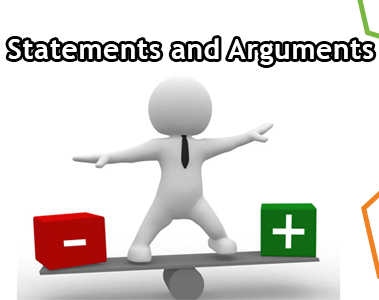Notes: Statement and Arguments | Logical Reasoning for UGC NET PDF Download
| Table of contents |

|
| Argument |

|
| What is Statement and Argument Reasoning? |

|
| Types of Argument |

|
| Shortcuts and Tricks for Statement and Argument Questions |

|
Argument
An argument in logical reasoning is a set of statements presenting a particular point of view, discussing various perspectives for or against a given topic.
Arguments play a crucial role in analytical reasoning, as questions related to inferences, assumptions, course of action, syllogism, etc., are intricately linked to argumentation. This makes arguments the fundamental aspect of analytical reasoning.
Key Concepts:
- Arguments are pivotal in analytical reasoning, forming the core of various question types.
- An argument comprises a series of statements advocating a specific viewpoint.
- Understanding arguments is crucial for mastering analytical reasoning.
Solved Examples:
- Example 1: Given the argument that all birds can fly, and an ostrich is a bird, can we conclude that an ostrich can fly?
- Example 2: If it is argued that exercise is essential for health, what assumptions can we derive from this statement?
Tips and Tricks:
- Always identify the main point of the argument.
- Look for underlying assumptions in the argument.
- Practice analyzing various types of arguments regularly.
- Use elimination methods to identify the correct answer in reasoning questions.
What is Statement and Argument Reasoning?
In simple terms, an argument represents a perspective on a specific issue backed by evidence. Candidates need to assess the strength of arguments provided, determining if they are weak or strong. Technically, an argument consists of a series of phrases, clauses, or sentences containing a claim or conclusion. This conclusion is drawn based on one or more statements, also known as premises or propositions.

Additionally, arguments may contain implicit premises known as assumptions.
Examples of Statement and Argument Reasoning:
- An argument: "Increasing the minimum wage will boost the economy."
- Implicit premise: "Economic growth is positively impacted by higher wages."
- Question type: "Arrange the following events in chronological order."
- Position test example: "Identify the correct order of participants."
Challenges in Statement and Argument Reasoning:
- Evaluating the strength of an argument
- Identifying hidden assumptions
- Applying logical reasoning to sequential problems
- Practice in analyzing and forming conclusions
Types of Argument
1. Weak Arguments
- Ambiguous Arguments: In this category of weak arguments, the statements lack clarity regarding their relevance to the situation at hand. The author's intentions are unclear, rendering these arguments weak in nature.
- Superfluous Arguments: Superfluous arguments fail to provide a thorough analysis, lacking depth and insight. Consequently, these arguments are considered weak.
- In weak arguments, the presented arguments lack depth and are superficial, diminishing their strength.
- Question-back Argument: These weak arguments involve the arguer responding with a question.
2. Strong Arguments
- Strong arguments are robust statements supported by evidence and reasoning.
- Established Facts: These arguments are based on established and generally true information.
- Experiences predict that the result will follow: Strong arguments based on past experiences or observations.
- Prevailing notion of truth: Arguments widely accepted as true or universally acknowledged.
 |
Download the notes
Notes: Statement and Arguments
|
Download as PDF |
Shortcuts and Tricks for Statement and Argument Questions
Identify the Statement Type:
- Policy or Decision-Based: Statements proposing a policy change or a decision.
- Opinion-Based: Statements based on personal or societal opinions.
Evaluate the Argument’s Strength:
- Relevance: Check if the argument directly relates to the statement.
- Specificity: General statements are often weaker than specific ones.
- Evidence: Arguments with factual or logical evidence are stronger.
Check for Common Fallacies:
- Ad Hominem: Attacking the person instead of the argument.
- Straw Man: Misrepresenting the argument to make it easier to attack.
- Red Herring: Introducing irrelevant information to distract from the main issue.
Analyze the Impact:
- Positive vs Negative Impact: Determine if the argument has a positive or negative impact on the issue.
- Short-Term vs Long-Term Impact: Consider both immediate and future consequences.
Consider Both Sides:
- Pros and Cons: Weigh the advantages and disadvantages presented in the arguments.
- Balanced Perspective: Strong arguments often present a balanced view, acknowledging both sides.
Use the Process of Elimination:
- Eliminate Weak Arguments: Discard arguments that are irrelevant, vague, or unsupported.
- Compare Remaining Arguments: Select the strongest arguments from the ones left.
Common Argument Types and How to Evaluate Them:
- Argument Based on Practicality: Is it feasible and does it solve a practical issue?
- Argument Based on Morality or Ethics: Does it align with common ethical standards?
- Argument Based on Financial or Economic Factors: Does it make economic sense?
Recognize Typical Strong Arguments:
- Arguments Promoting Health and Safety: Usually strong if they protect public well-being.
- Arguments Enhancing Education and Knowledge: Strong if they improve educational standards.
- Arguments Reducing Environmental Impact: Strong if they contribute to sustainability.
Example Application
Q1. Statement: Should public transportation be free for all citizens? Arguments:
(I) Yes, it will reduce traffic congestion and pollution.
(II) No, it will lead to overcrowding and financial strain on the government.
(III) Yes, it will make transportation accessible to everyone, especially the underprivileged.
Analysis Using Tricks
Relevance:
- Argument I is relevant to reducing traffic and pollution.
- Argument II is relevant to financial implications.
- Argument III is relevant to accessibility for underprivileged.
Impact:
- Argument I: Positive impact on environment and congestion.
- Argument II: Negative impact on government finances.
- Argument III: Positive social impact.
Evidence and Specificity:
- Argument I: Specific about environmental benefits.
- Argument II: Specific about financial and logistical issues.
- Argument III: Specific about social benefits.
Balanced Perspective:
- Both arguments I and III support the statement with positive outcomes.
- Argument II provides a counterpoint with practical concerns.
Conclusion:
- Arguments I and III are strong due to their positive impacts and relevance.
- Argument II is also strong as it provides a significant counterpoint regarding feasibility. Hence, the correct answer is (a).
Practice Strategy
- Read the Statement Carefully: Understand the core issue being discussed.
- Evaluate Each Argument Independently: Use the criteria above to assess the strength.
- Use Elimination Method: Discard the weakest arguments first.
- Balance the Arguments: Compare the remaining arguments for their overall impact.
|
31 videos|28 docs|14 tests
|
FAQs on Notes: Statement and Arguments - Logical Reasoning for UGC NET
| 1. What is the significance of Statement and Arguments in the UGC NET exam? |  |
| 2. How to approach Statement and Arguments questions in the UGC NET exam? |  |
| 3. What are the key strategies to solve Statement and Arguments questions effectively in the UGC NET exam? |  |
| 4. Can practicing Statement and Arguments questions help in scoring well in the UGC NET exam? |  |
| 5. How to differentiate between strong and weak arguments in the UGC NET exam? |  |




















